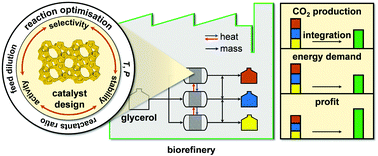Environmental and economical perspectives of a glycerol biorefinery†
Abstract
Glycerol conversion into chemicals and fuel additives is pursued to valorise a burgeoning by-product in the bioenergy sector. To this aim, heterogeneous catalysts have been developed that enable, in many cases, efficient and green transformations. Still, the evaluation of the environmental and economic footprint that would be associated with their large-scale application has often been neglected, limiting their commercial attractiveness. Furthermore, the impact of integrating different glycerol upgrading routes within a biorefinery, which is highly instrumental to determine the effective sustainability and profitability of biodiesel production from vegetable oils, has not been assessed. Here, the manufacture of the most relevant chemical derivatives of glycerol is considered, i.e., lactic acid, acrylic acid, glycerol carbonate, propanediols, epichlorohydrin and allyl alcohol. State-of-the-art catalysts for each upgrading route are briefly reviewed. Based on their performances, processes are rigorously modelled and relevant indicators, the global warming potential, the cumulative energy demand and the operating costs, quantified by life-cycle analysis. Glycerol-based processes are generally found more attractive than the conventional technologies nowadays applied for the production of the same chemicals, among which the paths to lactic acid and glycerol carbonate are particularly promising. In addition, the process variables mostly contributing to the environmental and cost metrics are identified. Accordingly, future studies should target further optimisation mainly in relation to selectivity, solvent volatility, reactants ratio and catalyst stability. Finally, the processes are integrated simulating a prospective glycerol biorefinery and the advantages deriving from the exchange of heat between the different routes quantified. If the glycerol feed is split equally among all routes the CO2 emissions and energy requirements are decreased by 15 and 32%, respectively, and the profit is increased by 5% as compared to the sum of the individual glycerol-based processes. In order to minimise the ecological impact of the biorefinery, glycerol should be rather divided in an 80 : 20 mass ratio among 1,2-propanediol and glycerol carbonate production, which are expected to have a significant market size. The innovative approach outlined in this work holds potential to guide both fundamental chemical research and process design in the development of CO2 and other bio-refineries.

- This article is part of the themed collection: 2018 Energy and Environmental Science HOT Articles


 Please wait while we load your content...
Please wait while we load your content...